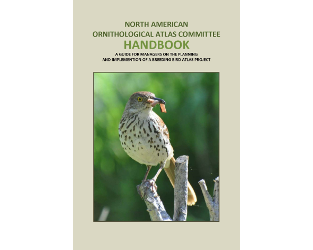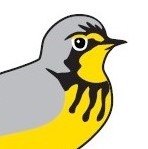
Ever wondered what goes on behind the scenes to create those amazing bird atlases?
We’re excited to announce the publication of a new guide on how to take a breeding bird atlas project from start to finish. The North American Ornithological Atlas Committee (NORAC) Handbook is an in-depth resource for anyone in North America or beyond who wants to pursue a bird atlas project, or who simply wants to know what goes into creating a bird atlas. We invite you to download and peruse this free resource in English or French.
What is a Breeding Bird Atlas?
A breeding bird atlas maps the distribution and relative abundance of breeding bird species across a specific geographic area (e.g., a province or region). An atlas project is a complex, collaborative, and multi-year undertaking. It includes everything from securing project funding, identifying suitable sampling strategies for collecting data, stewarding volunteers, managing and analyzing large amounts of data, creating maps, publishing results, and much more. In the new handbook, atlas organizers will find detailed information to guide them through every step.

Red-Necked Grebes Photo: Missy Mandel
Why Are Bird Atlases Important?
There are many reasons for pursuing atlas projects. The large scale of atlases makes them an effective way to track ecosystem health, and the results have important applications for wildlife management and conservation. For example, atlas results can be used to inform conservation policy, species at risk recovery, habitat management and stewardship, and more. Atlas projects are usually based on five years of field work and repeated in the same region at regular intervals (e.g., every 20 years), so results track changes over time. And because they are volunteer-driven, atlases are meaningful opportunities to get more people engaged in nature appreciation, Citizen Science, and conservation.
In Canada, breeding bird atlases involve collaboration among thousands of volunteer Citizen Scientists, Environment and Climate Change Canada, Bird Studies Canada, provincial governments, natural history and non-governmental organizations, and the private sector. There are several atlas projects currently underway in the country:
- The third year of data collection for Saskatchewan’s first breeding bird atlas begins in 2019;
- The full results of Manitoba’s first breeding bird atlas have recently been published online (open access);
- The Second Atlas of the Breeding Birds of Southern Québec will be available in bookstores starting April 2019;
- The potential for conducting a first breeding bird atlas in Newfoundland will be explored starting in 2019.
You can learn more about breeding bird atlases on Bird Studies Canada’s atlas webpage or in the new NORAC Handbook.
Like a bird atlas, the NORAC Handbook was a collaborative endeavor taking many years to complete. It was based on input from members of NORAC and the wider bird atlas community, and its principal recommendations have been endorsed by NORAC. The handbook was written and edited by Gregor Beck, Andrew Couturier, Charles Francis, and Seabrooke Leckie, and was published by Bird Studies Canada. Financial support for this initiative was provided by the Government of Canada.

